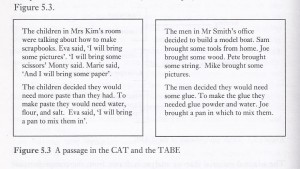Designing Worksheets
When I first considered designing original worksheets I remembered the book, From Testing to Assessment, which I read during the Diploma module Second Language Acquisition. The tests that interested me were written for Californian school children and later adapted for immigration exams in the USA. The tests require decoding, pushing students to use their English skills to solve an equation, which also offers a clear outcome – I was impressed by the test and keen to create something similar.
[From Testing To Assessment -English as an International Language C.Hill & K.Parry]
The images below are the first drafts of my worksheet, I tested the exercise sheet with a group of Italian teenagers.
Students were excited with the info graphic and carefully studied the information. The students were very familiar with the English words used in calculations but by the time they arrived at the riddle involving the mountain climbers they began to lose interest in the materials. The materials were also tested on pre-intermediate teen learners on short vacations and elementary Middle-eastern engineering summer school learners who retained interest in the materials for the mountain climber riddle but as the class was quite small I was of the opinion that the materials could more beneficial in an amended format. The image below of a reading activity about the rocky mountains, inspired me and I wanted to create something similar, where the students have partial understanding of the content of the text, through the pictures supplied.
[Materials Development in Language Teaching – Tomlinson]
This can be compared with the reading exercise below which although is extremely attractive employs no reading strategies and their is no clear outcome.
The activity is also designed for young learners who are usually relaxed about language learning and in my experience have responded very well to jigsaw reading activities. The recent story of two climbers in the Himalayas was suggested to me and I changed the design of my work sheet. I haven’t tried my updated materials but hope to do so soon. Please see below: –
Worksheets and Adapted Materials
I greatly enjoy teaching from the coursebook New Inside Out, the unit is colourful and exciting but the extra text below [Chocolate] in the teachers book is black and white and slightly boring. The text has various effective activities to accompany it and although the materials are very interesting and informative the text itself is quite difficult for an intermediate class. To remedy the problem I produced some pre-teach vocabulary matching cards; please follow the link cocaoreadingptvcards. The cards are cut up and students match the vocabulary with the corresponding pictures in pairs or small groups, the cards have proved very successful.
I have also updated two worksheets that were adapted from the New Inside Out students’ book. I have piloted the materials in several different formats but the final version shown below (please follow the link) proved to be most successful. The worksheets can be used with the activities above and have worked with a variety of students, supplementing coursebooks and during Content based language lessons (CLIL).
Worksheets and technology
I have tested my prepositional phrases worksheets on my students but felt that although stronger students were examining the content the materials could be more effective. In an attempt to solve the dilemma I created a powerpoint to accompany the worksheets, firstly to correct students’ answers and secondly to arouse interest. Please follow the links below for the powerpoint presentation and accompanying worksheets:
Prepositionalphrasespowerpoint
The presentation and accompanying worksheets are aimed at long-term students who use English every day and will need a strong command of English to communicate, they are also useful for summer students who are immersed in English and learn a lot of English in a short period of time. The phrases are useful but colloquial and are commonly used in spoken English and listening texts for International English Exams.
Games and Activities
I created the vocabulary exercise below for Pre-Intermediate – Intermediate level students The aim is to consolidate vocabulary knowledge on the subject of media. One person in a group has a card and must describe what is on the card until their group guess the word, on the card, in question. All the students take turns to describe a word, this continues for fifteen to twenty minutes before students move onto a short writing exercise.
If the lesson is being taught with an interactive whiteboard the images below should be shown on the board, if not they can be shown on a tablet or piece of paper. The aim is to elicit ideas about the media.
The activity below is also useful to check students’ levels, each student is given a headline and needs to write a news story which allows me as the teacher to assess students’ writing level and any gaps in student knowledge.
Graves, K. (2000) Designing Language Courses: A Guide for Teachers. Boston, MA MA.:Heinle & Heinle
C.Hill & K.Parry From Testing To Assessment -English as an International Language. London: Longman, 1994.
Jolly. R.D & Bolitho, R. (2011) A framework for materials writing. In Tomlinson, B. (ed). Materials Cambridge; Cambridge University Press pp.107-134
LittleJohn, A (ed). The analysis of language teaching materials: inside the Trojan Horse. In Tomlinson, B. (ed) Materials Development in Language Teaching. (2nd ed) Cambridge University Press. pp 179 – 211
McGrath, I. (2013) Teaching materials and the Roles of EFL/ESL Teachers: Practice and Theory.
Tomlinson, B. (2013) Developing principled frameworks for materials development. In Tomlinson, B. (ed). Developing Materials for Language Teaching. (2nd ed) London: Bloomsbury. pp 95 -118













